MmWave Tx-Rx Self-Interference Suppression through a High Impedance Surface Stacked EBG
Abstract
:1. Introduction
- Design: We present the design steps for a unit patch antenna, stacked EBG, and integration of stacked EBGs in between the antennas. We discuss the theoretical modelling of a band gap as an LC circuit and discuss how different components of EBG contribute to the inductance (L) and capacitance (C) behaviors of the LC circuit. We then refine the initial design with extensive HFSS (High Frequency Structure Simulator) simulations to provide a desirable balance between different objectives, such as return loss, frequency bandwidth, SI reduction, and antenna gain.
- Evaluation: We conduct extensive evaluations of our designs through both HFSS simulations and measurements of a prototype. Specifically, we conduct extensive over-the-air measurements of our antennas both inside and outside an anechoic chamber. Our results showed close correlation between simulations and real-world measurements with small deviations resulting from the manufacturing and measurement processes, e.g., we see an average of 2 dB difference in SI reduction prediction between simulation and measurement. However, the gaps can sometimes be large (e.g., more than 10 dB in return loss prediction) at lower and higher frequencies in the case of frequency bandwidth (return loss) plots. Further we show that the proposed design compared to not using EBGs provides more than 25 dB of additional reduction in SI over a 1 GHz of bandwidth.
2. Related Work
2.1. Full-Duplex Radio Design
2.2. Electromagnetic Band Gaps
3. Unit Antenna Element Design and Characterization
3.1. Design of the Rectangular Patch Antenna
3.2. Unit Antenna Characterization
4. High Impedance Surface Novel Stacked Electromagnetic Band Gap (HIS-nSEBG)
5. EBG Integration with Antennas and Its Operation
5.1. HIS-nSEBG Integration with Tx and Rx Antennas
5.2. Operating Mechanism of HIS-nSEBG
6. Measured and Simulated Self-Interference Suppression Results
6.1. Measurement Setup
6.2. Self-Interference Suppression Performance
6.3. Comparison with Other Related Designs
7. Conclusions
8. Future Work
Author Contributions
Funding
Data Availability Statement
Acknowledgments
Conflicts of Interest
Abbreviations
| BS | Base Station |
| FD | Full-Duplex |
| SI | Self-Interference |
| MIMO | Multiple Input Multiple Output |
| Tx | Transmit |
| Rx | Receive |
| HFSS | High Frequency Structure Simulator |
| EBG | Electromagnetic Band Gap |
| HIS-nSEBG | High Impedance Surface novel Stacked Electromagnetic Band Gap |
References
- Ericsson: Mobile Network Traffic Update. Available online: https://www.ericsson.com/en/reports-and-papers/mobility-report/dataforecasts/mobile-traffic-forecast (accessed on 1 August 2024).
- Duarte, M.; Sabharwal, A. Full-Duplex Wireless Communications Using Off-the-shelf Radios: Feasibility and First Results. In Proceedings of the 2010 Conference Record of the Forty Fourth Asilomar Conference on Signals, Systems and Computers, Pacific Grove, CA, USA, 7–10 November 2010; pp. 1558–1562. [Google Scholar]
- Choi, J.I.; Jain, M.; Srinivasan, K.; Levis, P.; Katti, S. Achieving Single Channel, Full Duplex Wireless Communication. In Proceedings of the 16th Annual International Conference on Mobile Computing and Networking and The 11th ACM International Symposium on Mobile Ad Hoc Networking and Computing, Chicago, IL, USA, 20–24 September 2010. [Google Scholar]
- Khandani, A.K. Methods for Spatial Multiplexing of Wireless Two-Way Channels. U.S. Patent US7,817,641, 19 October 2010. [Google Scholar]
- Smida, B.; Sabharwal, A.; Fodor, G.; Alexandropoulos, G.C.; Suraweera, H.A.; Chae, C.B. Full-Duplex Wireless for 6G: Progress Brings New Opportunities and Challenges. IEEE J. Sel. Areas Commun. 2023, 41, 2729–2750. [Google Scholar] [CrossRef]
- Ansys HFSS. Available online: https://www.ansys.com/products/electronics/ansys-hfss (accessed on 1 August 2024).
- Yon, H.; Rahman, N.H.A.; Aris, M.A.; Jamaluddin, M.H.; Lin, I.K.C.; Jumaat, H.; Redzwan, F.N.M.; Yamada, Y. Development of C-Shaped Parasitic MIMO Antennas for Mutual Coupling Reduction. Electronics 2021, 10, 2431. [Google Scholar] [CrossRef]
- Lin, X.J.; Xie, Z.M.; Zhang, P.S. Integrated Filtering Microstrip Duplex Antenna Array with High Isolation. Int. J. Antennas Propag. 2017, 2017, 4127943. [Google Scholar] [CrossRef]
- Everett, E.; Sahai, A.; Sabharwal, A. Passive Self-Interference Suppression for Full-Duplex Infrastructure Nodes. IEEE Trans. Wirel. Commun. 2014, 13, 680–694. [Google Scholar] [CrossRef]
- Slingsby, W.T.; McGeehan, J.P. Antenna isolation measurements for on-frequency radio repeaters. In Proceedings of the 1995 Ninth International Conference on Antennas and Propagation, ICAP ’95 (Conf. Publ. No. 407), Eindhoven, The Netherlands, 4–7 April 1995; Volume 1, pp. 239–243. [Google Scholar]
- Ramos, A.; Varum, T.; Matos, J.N. A Review on Mutual Coupling Reduction Techniques in mmWaves Structures and Massive MIMO Arrays. IEEE Access 2023, 11, 143143–143166. [Google Scholar] [CrossRef]
- Aryafar, E.; Khojastepour, M.A.; Sundaresan, K.; Rangarajan, S.; Chiang, M. MIDU: Enabling MIMO Full Duplex. In Proceedings of the 18th Annual International Conference on Mobile Computing and Networking, Istanbul, Turkey, 22–26 August 2012. [Google Scholar]
- Madni, A.; Khan, W.T. Design of a Compact 4-Element GNSS Antenna Array With High Isolation Using a Defected Ground Structure (DGS) and a Microwave Absorber. IEEE Open J. Antennas Propag. 2023, 4, 779–791. [Google Scholar] [CrossRef]
- Wu, D.; Cheung, S.W.; Li, Q.L.; Yuk, T.I. Decoupling using diamond-shaped patterned ground resonator for small MIMO antennas. IET Microw. Antenna Propag. 2017, 11, 177–183. [Google Scholar] [CrossRef]
- Iwamoto, K.; Heino, M.; Haneda, K.; Morikawa, H. Design of an Antenna Decoupling Structure for an Inband Full-Duplex Collinear Dipole Array. IEEE Trans. Antennas Propag. 2018, 66, 3763–3768. [Google Scholar] [CrossRef]
- Nawaz, H.; Tekin, I. Dual-Polarized, Differential Fed Microstrip Patch Antennas with Very High Interport Isolation for Full-Duplex Communication. IEEE Trans. Antennas Propag. 2017, 65, 7355–7360. [Google Scholar] [CrossRef]
- Sim, C.Y.D.; Chang, C.C.; Row, J.S. Dual-Feed Dual-Polarized Patch Antenna with Low Cross Polarization and High Isolation. IEEE Trans. Antennas Propag. 2009, 57, 3321–3324. [Google Scholar] [CrossRef]
- Kolodziej, K.E.; McMichael, J.G.; Perry, B.T. Multitap RF Canceller for In-Band Full-Duplex Wireless Communications. IEEE Trans. Wirel. Commun. 2016, 15, 4321–4334. [Google Scholar] [CrossRef]
- Aryafar, E.; Keshavarz-Haddad, A. PAFD: Phased Array Full-Duplex. In Proceedings of the IEEE INFOCOM 2018—IEEE Conference on Computer Communications, Honolulu, HI, USA, 16–19 April 2018. [Google Scholar]
- Reiskarimian, N.; Dastjerdi, M.B.; Zhou, J.; Krishnaswamy, H. Analysis and Design of Commutation-Based Circulator-Receivers for Integrated Full-Duplex Wireless. IEEE J. Solid-State Circuits 2018, 53, 2190–2201. [Google Scholar] [CrossRef]
- Singh, V.; Mondal, S.; Gadre, A.; Srivastava, M.; Paramesh, J.; Kumar, S. Millimeter-Wave Full Duplex Radios. In Proceedings of the 26th Annual International Conference on Mobile Computing and Networking, London, UK, 21–25 September 2020; pp. 1–14. [Google Scholar] [CrossRef]
- Elsheakh, D.M.N.; Elsadek, H.; Abdallah, E.A. Antenna Designs with Electromagnetic Band Gap Structures. In Metamaterial; InTech: Rijeka, Croatia, 2012; pp. 403–473. [Google Scholar]
- Yang, F.; Rahmat-Samii, Y. Microstrip Antennas Integrated with Electromagnetic Band-Gap (EBG) Structures: A Low Mutual coupling Design for Array Applications. IEEE Trans. Antennas Propag. 2003, 54, 2936–2946. [Google Scholar] [CrossRef]
- Dey, S.; Dey, S.; Koul, S.K. Isolation Improvement of MIMO Antenna using Novel EBG and Hair-Pin Shaped DGS at 5G Millimeter Wave Band. IEEE Access 2021, 9, 162820–162834. [Google Scholar] [CrossRef]
- Yang, F.; Rahmat-Samii, Y. Electromagnetic Band Gap Structures in Antenna Engineering; Cambridge University Press: Cambridge, UK, 2009. [Google Scholar]
- Ghosh, S.; Tran, T.N.; Le-Ngoc, T. Dual-Layer EBG-Based Miniaturized Multi-Element Antenna for MIMO Systems. IEEE Trans. Antennas Propag. 2014, 62, 3985–3997. [Google Scholar] [CrossRef]
- Farahani, H.S.; Veysi, M.; Kamyab, M.; Tadjalli, A. Mutual Coupling Reduction in Patch Antenna Arrays Using a UC-EBG Superstrate. IEEE Antennas Wirel. Propag. Lett. 2010, 9, 57–59. [Google Scholar] [CrossRef]
- Al-Hasan, M.J.; Denidni, T.A.; Sebak, A.R. Millimeter-Wave Compact EBG Structure for Mutual Coupling Reduction Applications. IEEE Trans. Antennas Propag. 2015, 63, 823–828. [Google Scholar] [CrossRef]
- Lamminen, A.E.I.; Vimpari, A.R.; Saily, J. UC-EBG on LTCC for 60-GHz Frequency Band Antenna Applications. IEEE Trans. Antennas Propag. 2009, 57, 2904–2912. [Google Scholar] [CrossRef]
- Qiu, L.; Zhao, F.; Xiao, K.; Chai, S.L.; Mao, J.J. Transmit–Receive Isolation Improvement of Antenna Arrays by Using EBG Structures. IEEE Antennas Wirel. Propag. Lett. 2012, 11, 93–96. [Google Scholar]
- Oladeinde, A.K.; Aryafar, E.; Pejcinovic, B. EBG-Based Self-Interference Cancellation to Enable mmWave Full-Duplex Wireless. In Proceedings of the 2021 IEEE Texas Symposium on Wireless and Microwave Circuits and Systems (WMCS), Waco, TX, USA, 18–20 May 2021. [Google Scholar]
- Oladeinde, A.K.; Aryafar, E.; Pejcinovic, B. EBG Placement Optimization in a Via-Fed Stacked Patch Antenna for Full-Duplex Wireless. In Proceedings of the 2022 IEEE-APS Topical Conference on Antennas and Propagation in Wireless Communications (APWC), Cape Town, South Africa, 5–9 September 2022. [Google Scholar]
- Pre-Preg. Available online: https://en.wikipedia.org/wiki/Pre-preg (accessed on 1 August 2024).
- Anritsu Test and Measurement Equipment. Available online: https://www.anritsu.com/en-us/ (accessed on 1 August 2024).
- MilliBox: Benchtop mmWave Antenna Test System. Available online: https://millibox.org/ (accessed on 1 August 2024).
- Hassan, M.A.M.; Kishk, A. Bandwidth Study of the Stacked Mushroom EBG Unit Cells. IEEE Trans. Antennas Propag. 2017, 68, 4357–4362. [Google Scholar] [CrossRef]
- Yang, F.; Rahmat-Samii, Y. Reflection Phase Characterizations of the EBG Ground Plane for Low Profile Wire Antenna Applications. IEEE Trans. Antennas Propag. 2003, 51, 2691–2703. [Google Scholar] [CrossRef]
- Jiao, T.; Jiang, T.; Li, Y. Antenna Array Coupling Reduction Based on Stacked EBG Structures. In Proceedings of the 2017 International Applied Computational Electromagnetics Society Symposium (ACES), Suzhou, China, 1–4 August 2017. [Google Scholar]
- Qiang, J.; Xu, F.; Fan, W. Reducing Mutual Coupling of Millimeter Wave Array Antennas by Fractal Defected Ground Structure. In Proceedings of the 2018 12th International Symposium on Antennas, Propagation and EM Theory (ISAPE), Hangzhou, China, 3–6 December 2018; pp. 1–3. [Google Scholar] [CrossRef]
- Wei, K.; Li, J.Y.; Wang, L.; Xing, Z.J.; Xu, R. Mutual Coupling Reduction by Novel Fractal Defected Ground Structure Bandgap Filter. IEEE Trans. Antennas Propag. 2016, 64, 4328–4335. [Google Scholar] [CrossRef]
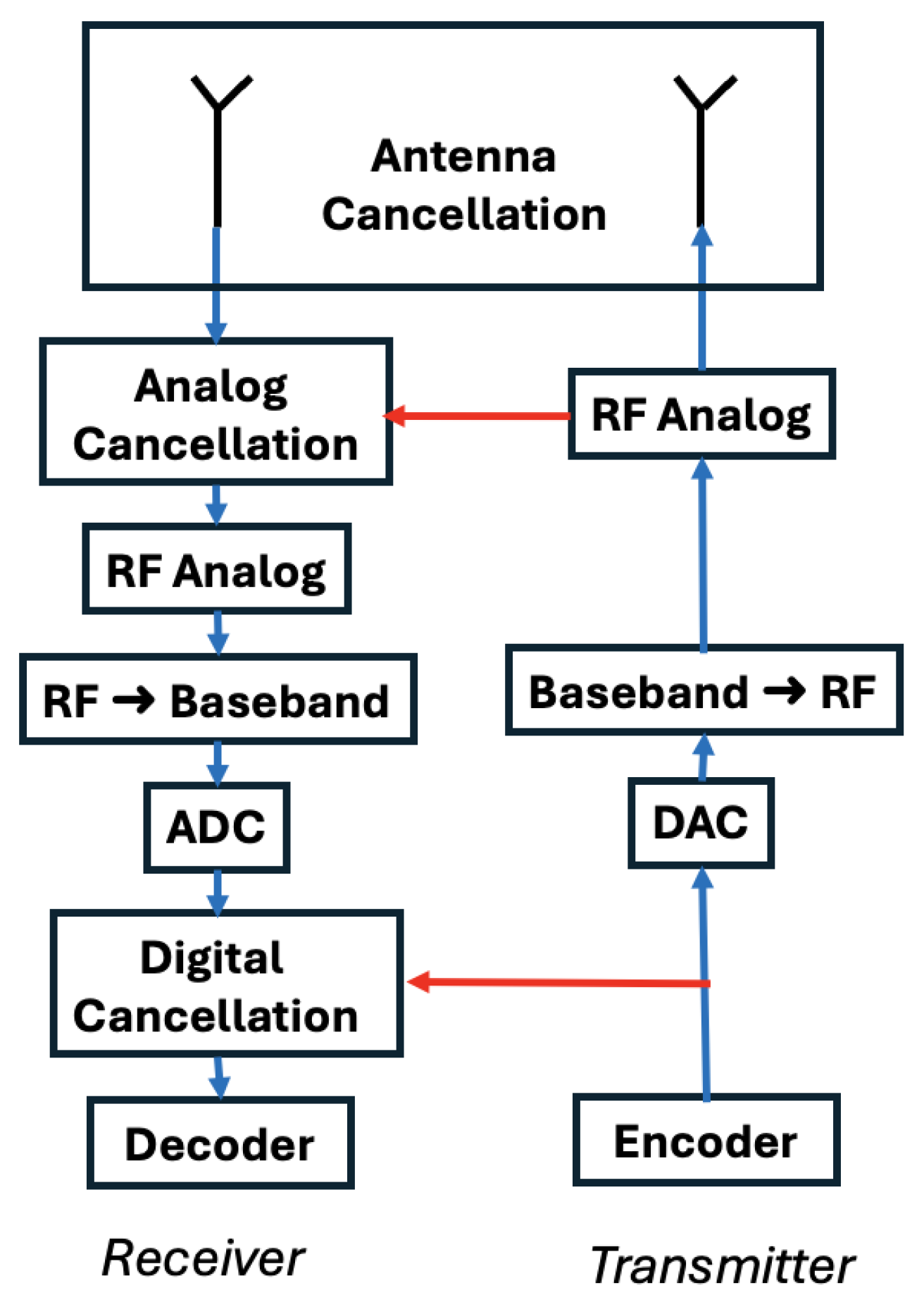
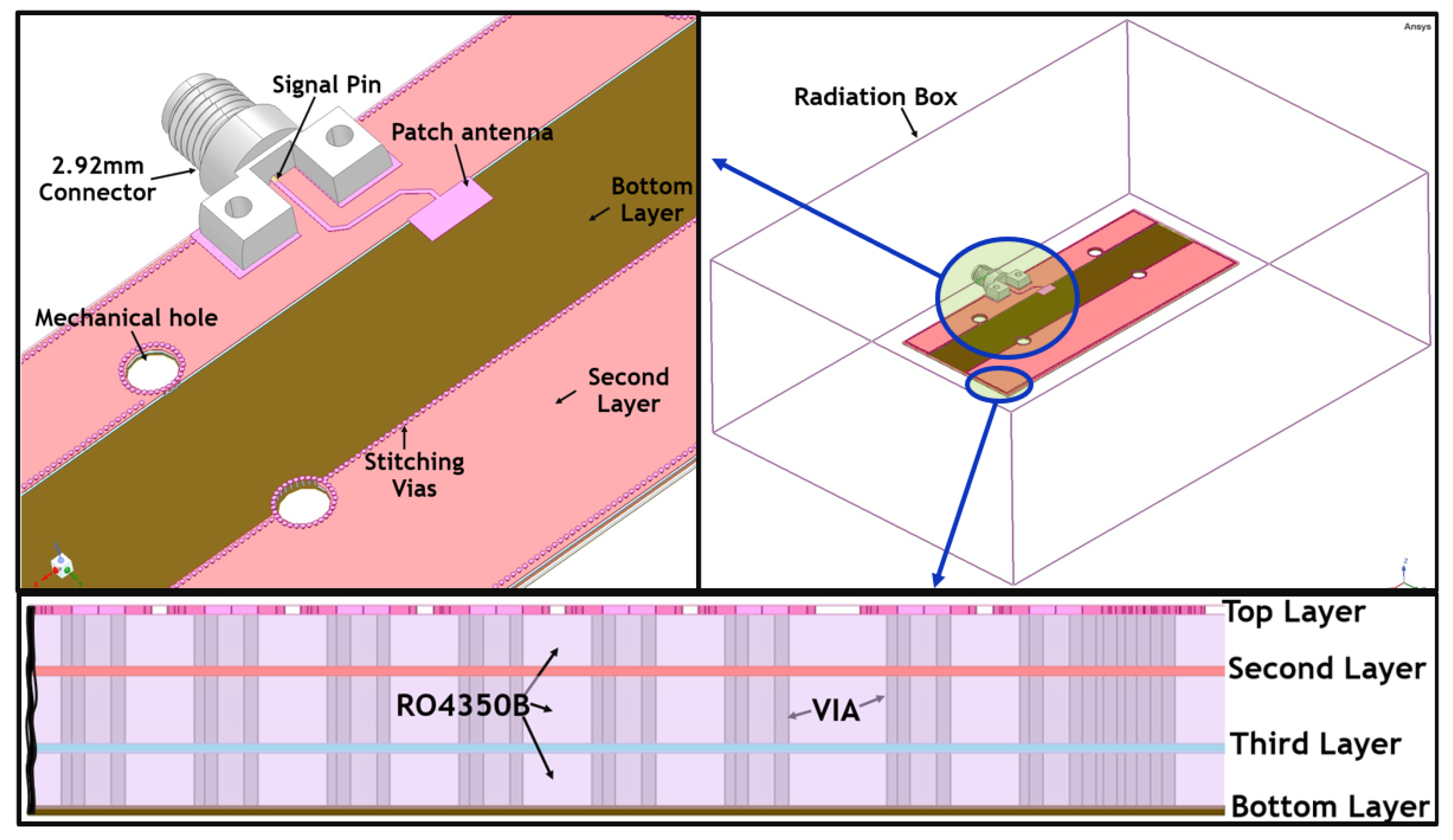
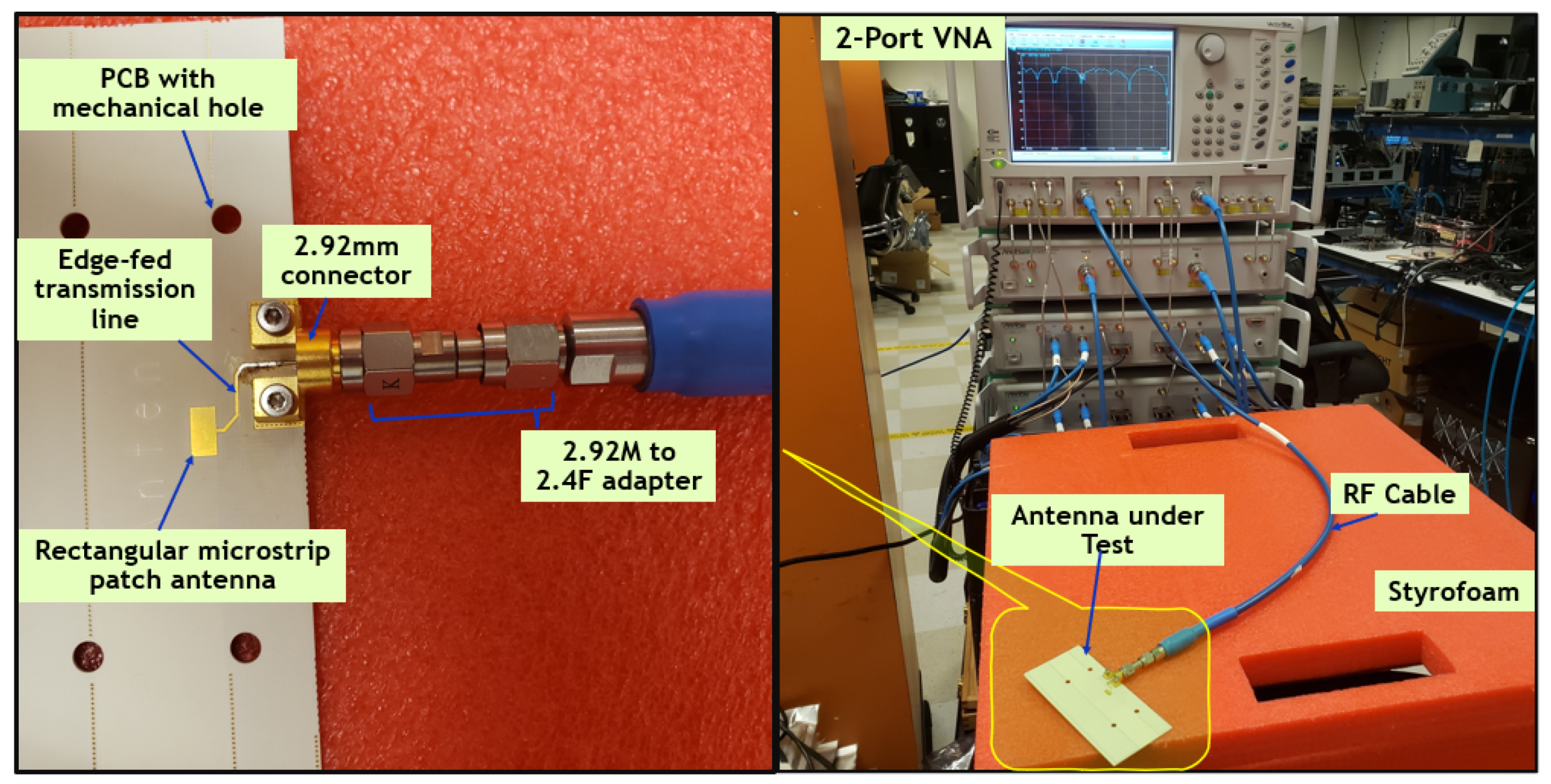
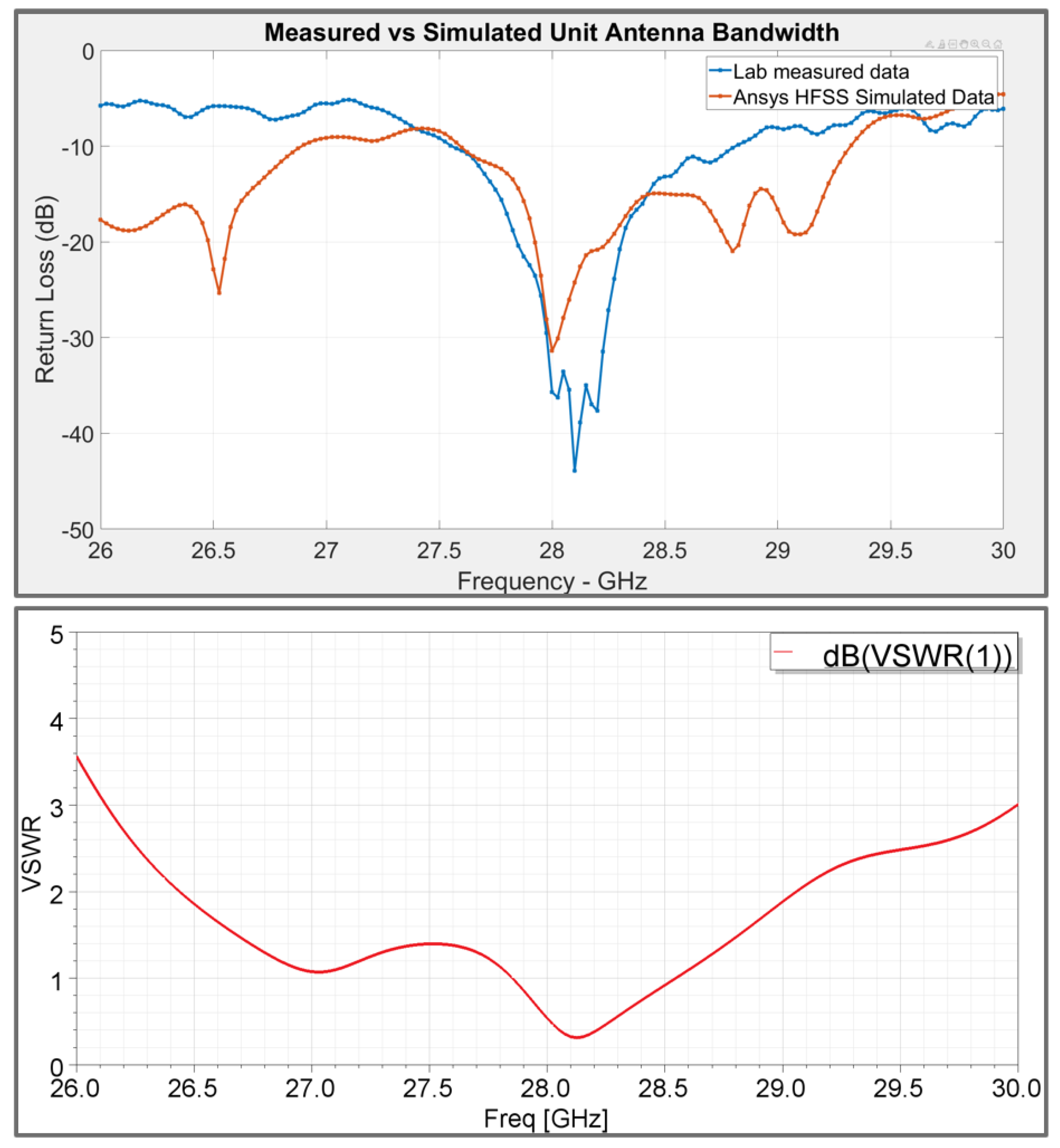
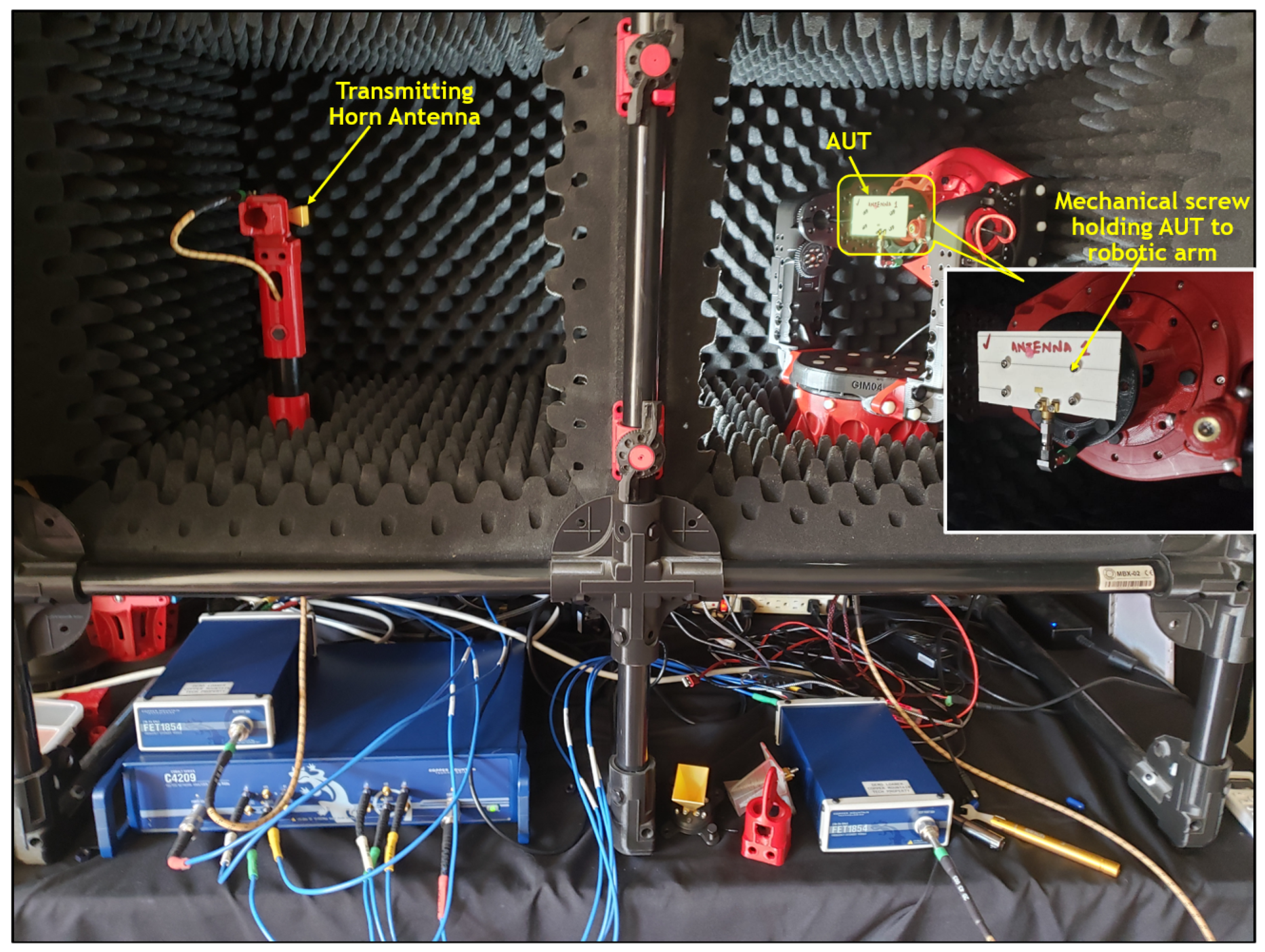
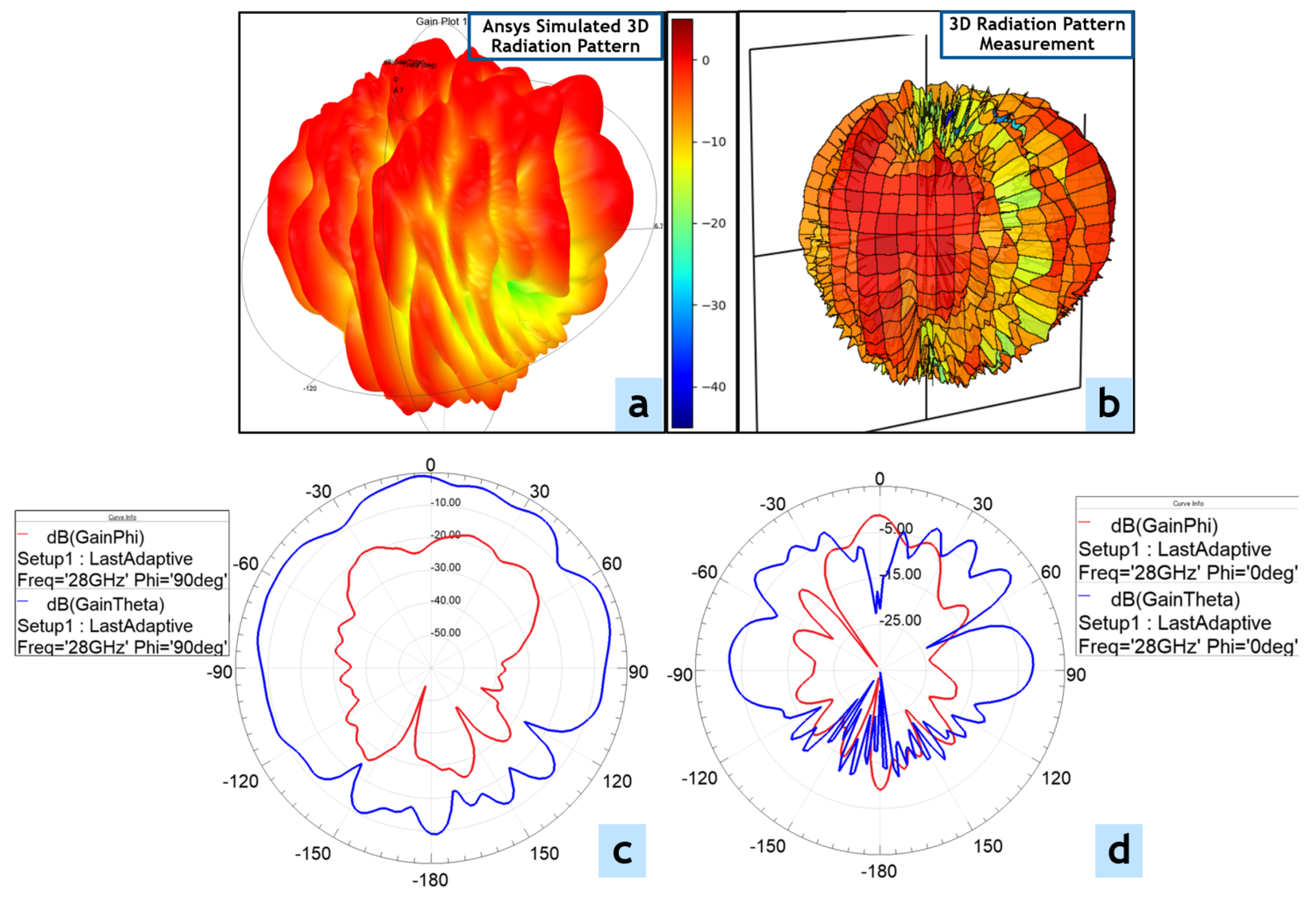


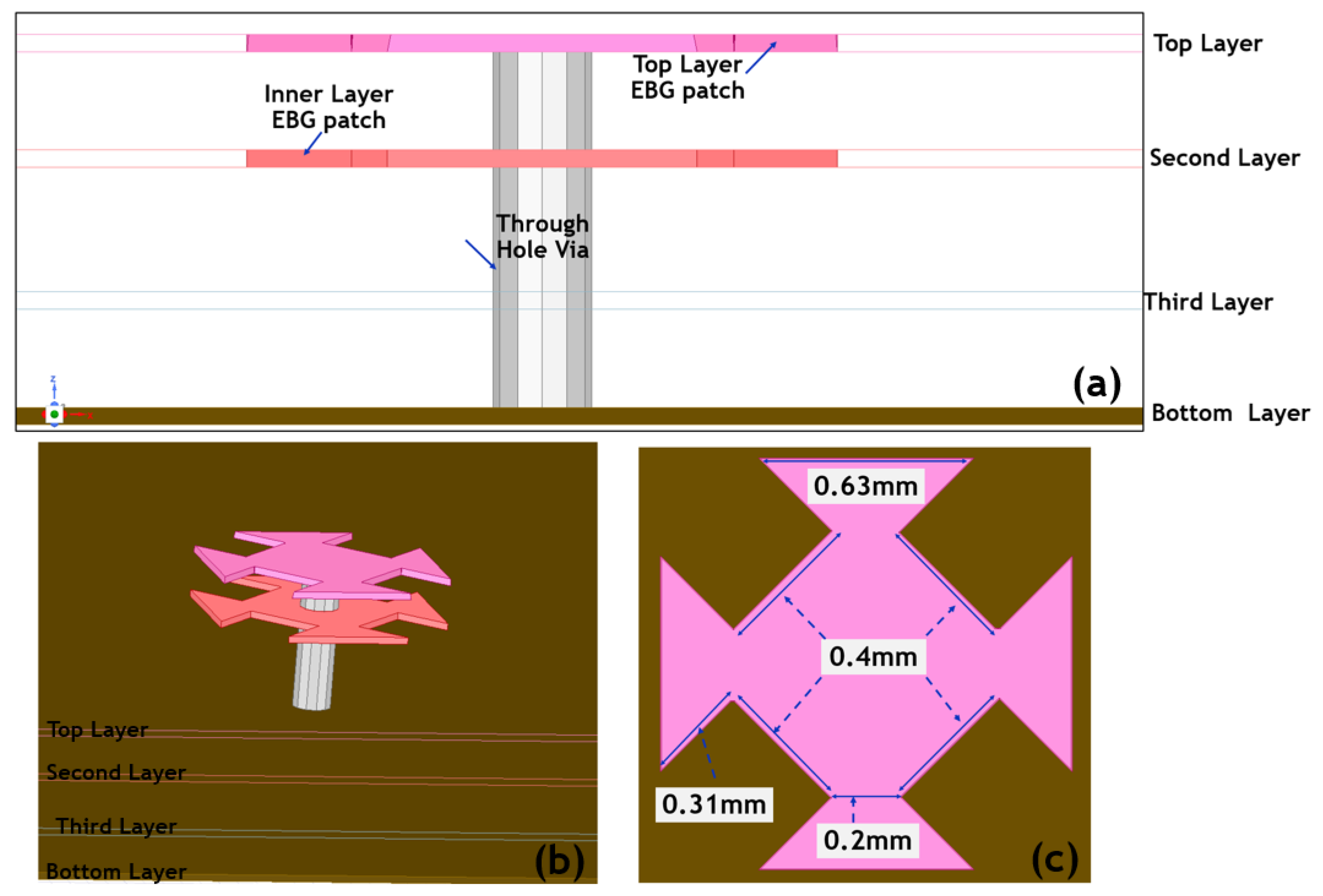

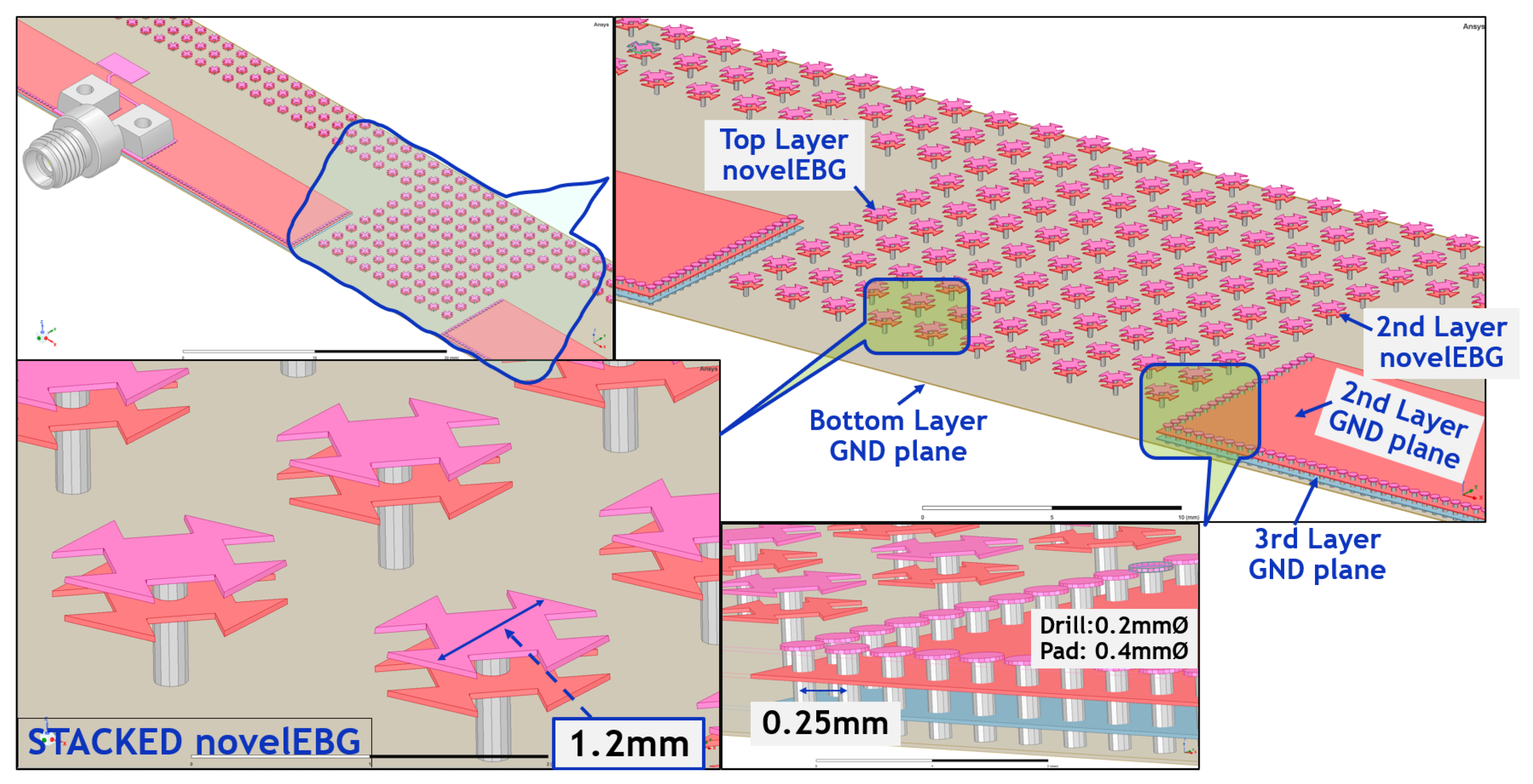
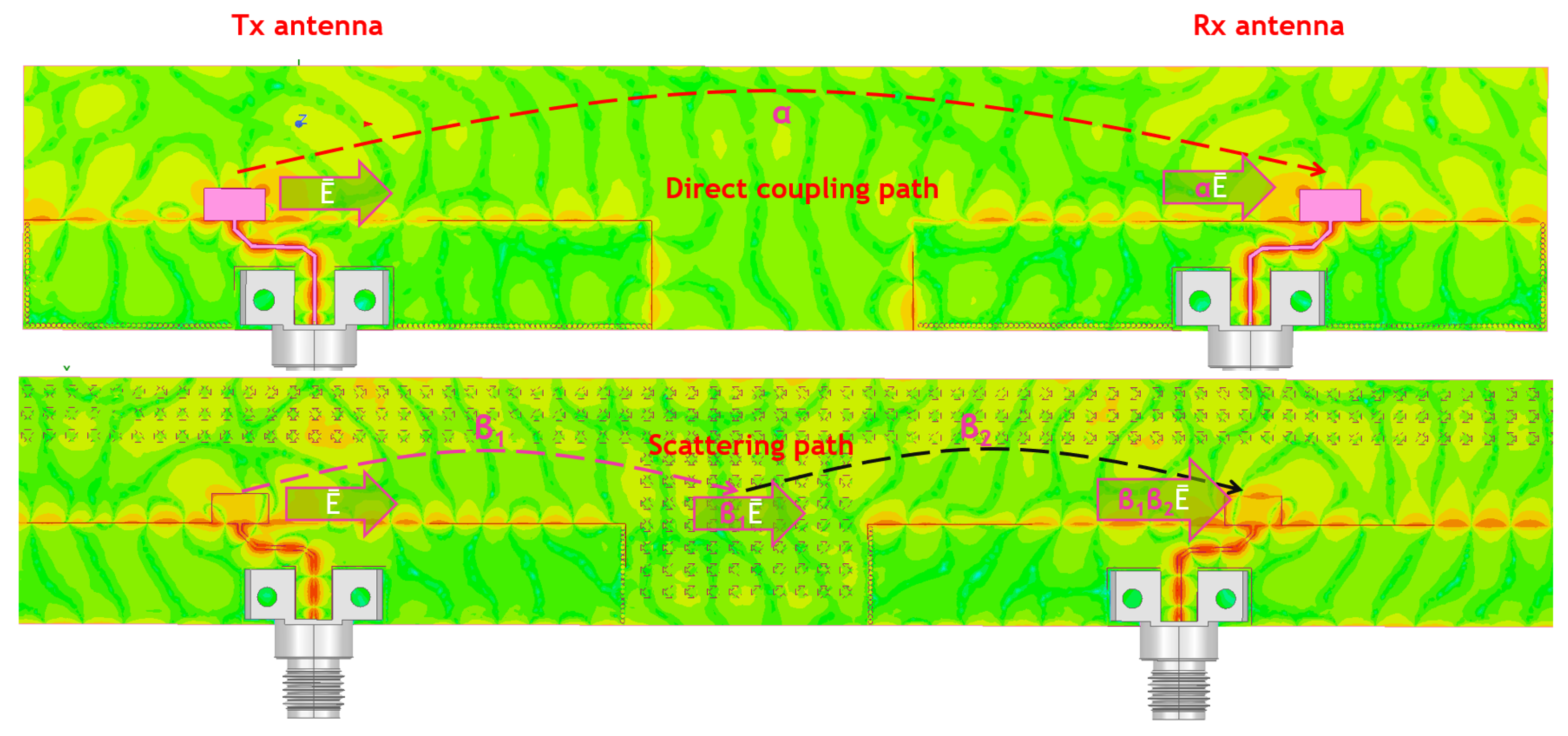
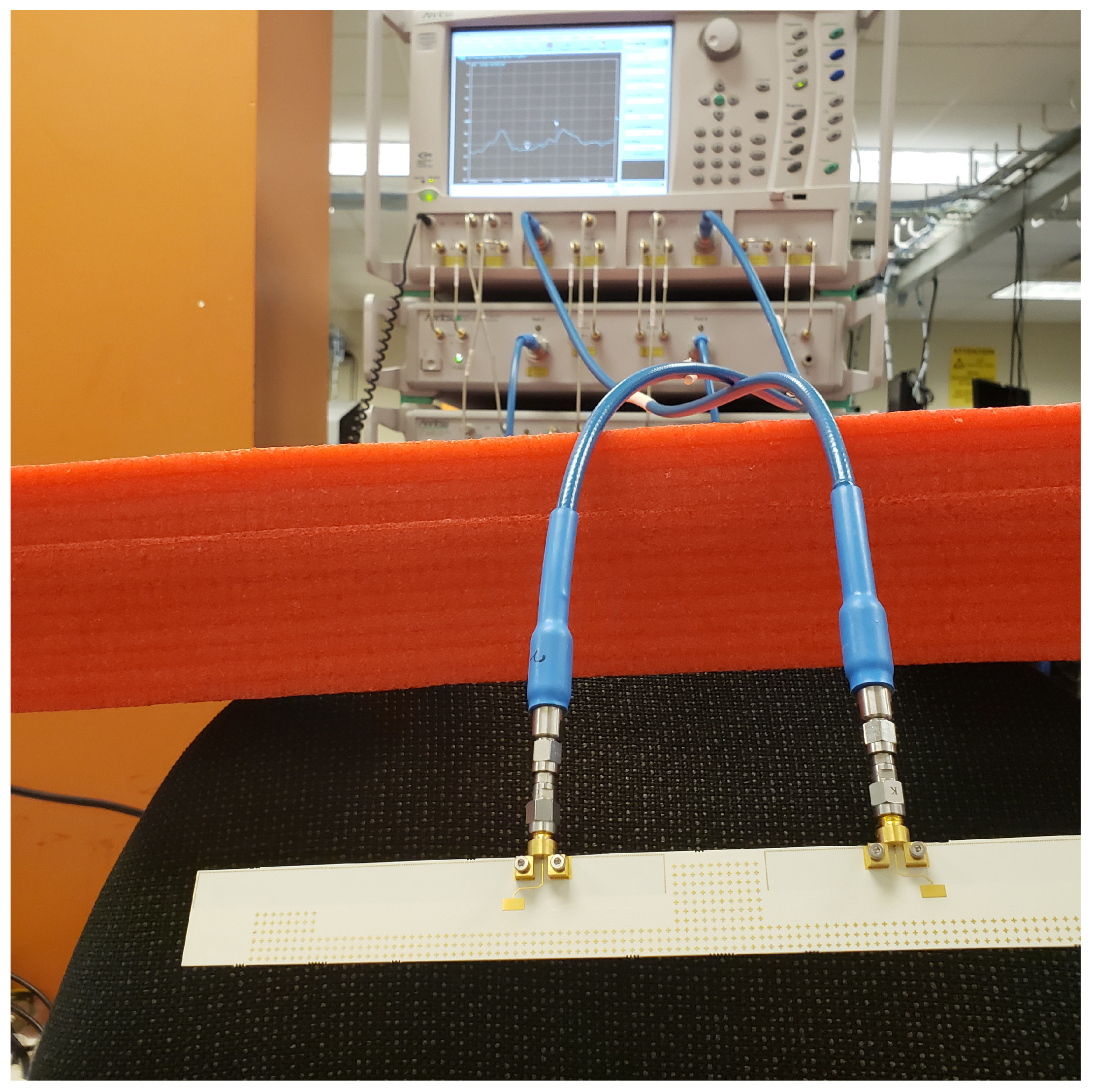
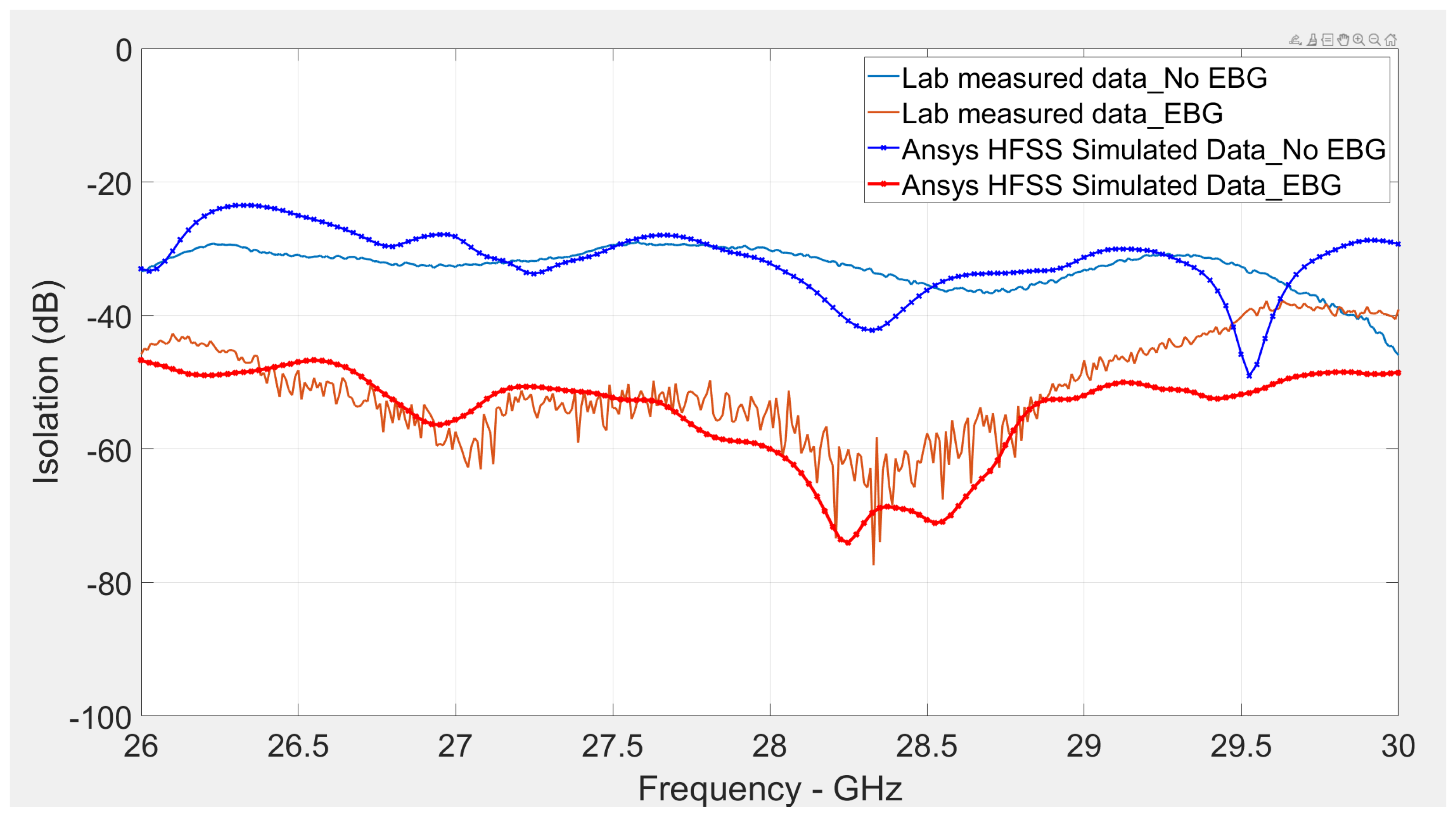
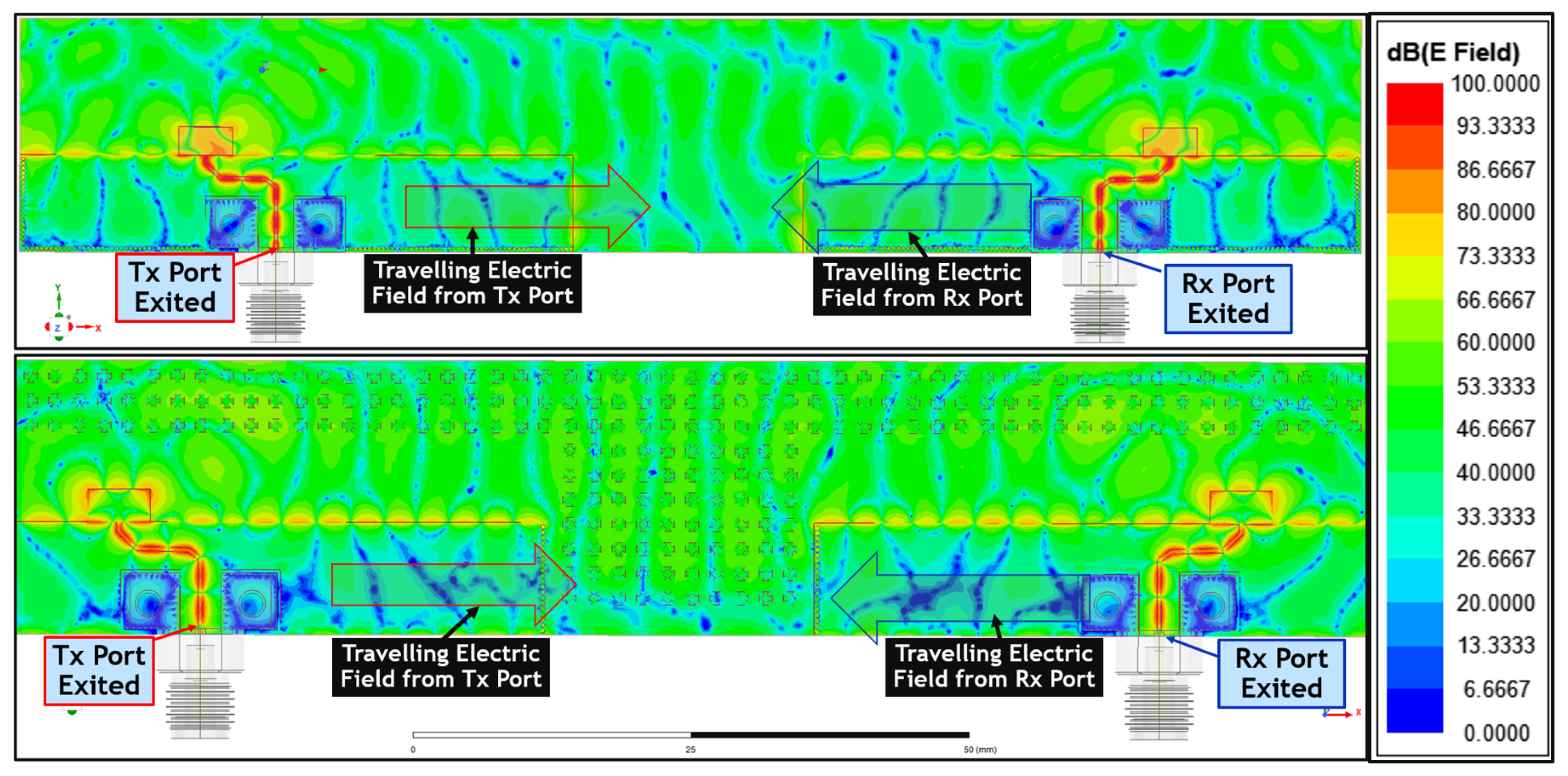
| Ref. | Operating Frequency | EBG/DGS Type | Periodicity () [Length × Width] | Total Mutual Coupling Level Reduction @ 200 MHz BW Isolation of Operating Frequency |
|---|---|---|---|---|
| [24] | 28 GHz | novel EBG & DGS | 2.05 mm × 2.05 mm | −14 dB with EBG −48 dB with EBG & DGS |
| [27] | Sub-6 GHz | UC-EBG | 6.6 mm × 6.6 mm | within −30 dB |
| [28] | 60 GHz | UC-EBG | 0.98 mm × 0.23 mm | <−30 dB |
| [29] | 60 GHz | UC-EBG | 1.1 mm × 1.1 mm | within −20 dB for E-plane coupling and −30 dB for H-plane coupling |
| [30] | 12 GHz | Mushroom EBG with Choke Structures | 1.6 mm × 1.6 mm | −55 dB |
| [31] | 28 GHz | Vicross EBG (Our prior work) | 1.3 mm × 1.3 mm | −60 dB and >−68 dB of Peak Mutual coupling reduction |
| [32] | 28 GHz | Stacked EBG (Our prior work) | 0.6 mm × 0.6 mm | −60 dB and >−80 dB of Peak Mutual coupling reduction |
| [39] | 12 GHz | Fractal Defected Ground Structure | 8.5 mm × 8.5 mm | −33 dB |
| [40] | 2.4 GHz | Fractal Defected Ground Structure | 22.2 mm × 22.2 mm | −60 dB |
| This work | 28 GHz | HIS-nEBG | 1.2 mm × 1.2 mm | −60 dB, −72 dB of peak mutual coupling reduction and −25 dB of Isolation improvement with HIS-nEBG |
Disclaimer/Publisher’s Note: The statements, opinions and data contained in all publications are solely those of the individual author(s) and contributor(s) and not of MDPI and/or the editor(s). MDPI and/or the editor(s) disclaim responsibility for any injury to people or property resulting from any ideas, methods, instructions or products referred to in the content. |
© 2024 by the authors. Licensee MDPI, Basel, Switzerland. This article is an open access article distributed under the terms and conditions of the Creative Commons Attribution (CC BY) license (https://creativecommons.org/licenses/by/4.0/).
Share and Cite
Oladeinde, A.K.; Aryafar, E.; Pejcinovic, B. MmWave Tx-Rx Self-Interference Suppression through a High Impedance Surface Stacked EBG. Electronics 2024, 13, 3067. https://doi.org/10.3390/electronics13153067
Oladeinde AK, Aryafar E, Pejcinovic B. MmWave Tx-Rx Self-Interference Suppression through a High Impedance Surface Stacked EBG. Electronics. 2024; 13(15):3067. https://doi.org/10.3390/electronics13153067
Chicago/Turabian StyleOladeinde, Adewale K., Ehsan Aryafar, and Branimir Pejcinovic. 2024. "MmWave Tx-Rx Self-Interference Suppression through a High Impedance Surface Stacked EBG" Electronics 13, no. 15: 3067. https://doi.org/10.3390/electronics13153067
APA StyleOladeinde, A. K., Aryafar, E., & Pejcinovic, B. (2024). MmWave Tx-Rx Self-Interference Suppression through a High Impedance Surface Stacked EBG. Electronics, 13(15), 3067. https://doi.org/10.3390/electronics13153067







